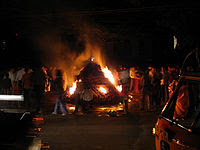
Situated on the banks of river Sabarmati, Ahmedabad is located on the western side of India in the state of Gujarat Ahmedabad city has witnessed the rule of different dynasties, right from Sultanate and Mughal rule to Maratha and British rule. The, the history of Ahmedabad, India is very rich. Ahmedabad was the former capital city of Gujarat. During the freedom struggle of India, it served as the home of many prominent nationalist leaders like Sardar Patel and Mahatma Gandhi
Origin of NameThere is an interesting legend associated with the Ahmedabad city. Towards the beginning of the fifteenth century, the state of Gujarat was ruled by the Muslim Muzaffarid dynasty. Once Sultan Ahmed Shah was standing on the banks of river Sabarmati and he noticed a tiny hare chasing a strong ferocious dog. He kept pondering over it. He approached a spiritual leader and asked for explanation. This learned man said that, it is the uniqueness of this land that cultivates such rare qualities in its people. After having heard this, the Sultan got so impressed that he decided to set up the capital of Gujarat over here and he called this land Ahmedabad.
Sultanate RuleTowards the end of the thirteenth century, Gujarat was captured by the Sultanate of Delhi. In the year 1487, the grandson of Ahmed Shah named Mahmud Begada established the outer city wall, so as to protect Ahmedabad from outside invasion. Muzaffar II was the last Sultan of Ahmedabad.
Mughal RuleIn the year 1573, the city of Ahmed Shah was taken over by the Mughal emperor Akbar. Under the rule of Mughals, Ahmedabad became the leading center of textiles in Gujarat. The son of Akbar named Jehangir visited Ahmedabad in 1617, but found the city to be nothing more than a garbage ground. So, he called it Gardabad, the city of dust. However, Shahjahan spent a major part of his life in the Ahmedabad city. Infact, he also constructed the Moti Shahi Mahal in Shahibaugh.
Maratha RuleIn the year 1753, the rule of Mughals came to an end and the city came under the rule of Maratha generals Raghunath Rao and Damaji Gaekwad. The power struggle between them eventually led to the destruction of the city.
British Rule
The city was taken over by the British East India Company in the year 1818. The year 1824 led to the setting up of a military cantonment. A major development took place in the year 1864, when railway line was laid that connected Ahmedabad with Bombay. These developments brought Ahmedabad in the map of leading centers of trade and manufacturing. In the year 1915, people of Ahmedabad raised their voice for the independence of India.
Post IndependenceThe post independence period saw the declaration of Ahmedabad as a provincial town on Bombay. On the 1st of May in the year 1960. AHmedabad became the capital city of Gujarat.
WEATHERCLIMATE: Extreme type
SUMMER TEMPERATURE: Minimum 23 degree C / 73.4 degree F
Maximum 40 degree C / 104 degree F
WINTER TEMPERATUE: Minimum 15 degree C / 59 degree F
Maximum 36 degree C / 95 degree F
ANNUAL RAINFALL: 93.2 cm / 36.7 in
Ahmedabad is dominated by three main seasons, namely summer, monsoon and winter. The climatic conditions of Ahmedabad vary from season to season. Located at an altitude of 55m above the sea level. Ahmedabad city primarily experiences extreme type of climate. There is a lot of difference in the day and night temperatures.
Talking about the climate and weather of Ahmedabad, it is usually hot and moist. Summer season begins during March and ends by the month of June. Monsoons come like a pleasant surprise in the month of July and are prevalent in the city till the month of September. Winters are chilly, but at the same time very enjoyable. This season dominates the city during the period between November and February.
Summer are extremely hot and hard and at times the temperature shoots to as high as 46 degree C. During monsoons, the city experiences good amount of rainfall. The city is dominated by the Southwest monsoons and it is during this time that people of Ahmedabad breathe a sigh of relief from the scorching heat. For traveling to Ahmedabad, the best time is during winters, as the weather is very pleasant and just apt to explore the beautiful Ahmedabad city.










